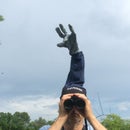Introduction: Clinometer
This is a simple tool that uses some basic trigonometry to measure the height of trees.
This tool is a 45-45-90 triangle and thus an isosceles triangle. Isosceles triangles have two legs of equal length. By using a 45-45-90 triangle to placed yourself at a distance from a tree trunk, you create an triangle where the distance from the trunk is also the height of the tree.
I’ve used this to measure heights of trees I’ve nominated to be state champions.
Most U.S. states have a website dedicated to the the largest known individual of each tree species in their state.*
There’s an algorithm for assessing a score for each tree. One point is awarded for every foot of height. One point is awarded for every inch of circumference of the trunk at 4.5 feet high. One-quarter point is awarded for every foot of canopy diameter. Height is usually the hardest thing to measure, so most people use some version of a tool called a clinometer.
There are a wide variety of clinometers. A low-tech plastic one, quite similar to this one, runs about $10. A variable clinometer that works at many different angles costs about $100, and a laser-using hypsometer can be bought for about $400. But this is an easy project, is close to free, and is fairly accurate.
*An example of a program dedicated to big trees is Virginia’s website “Virginia Big Trees”. It can be found at http://bigtree.cnre.vt.edu/index.html
“American Forests” magazine keeps the record for trees that are national champions and lists them at this website. https://www.americanforests.org/ They also an 85-page booklet on measuring trees, as measuring parameters can get complicated if the tree is not on flat ground, has multiple trunks, is leaning, or is doing anything but growing vertically on flat open ground.
Step 1: Tools and Supplies
Tools:
measuring tape (most champion tree sites use feet and inches as their units)
scissors or a box cutter
hacksaw, perhaps
Materials:
corrugated cardboard
glue
two small tubes ( I cut two tubes from the cardboard barrel of a ball-point pen)
duck tape
small level (key chain size is fine)
clear packing tape
Step 2: Cut and Glue
Cut a 45-45-90 triangle out of corrugated cardboard. If you have a 90 degree corner and two legs of equal length, you’ll have a 45-45-90 triangle. You don’t need a protractor to measure the angles.
I made 8 inch x 8 inch squares and then cut across the diagonal to make 45-45-90 triangles with 8 inch legs. I glued three layers of cardboard together to make it thicker and stouter, but multiple layers aren’t really necessary.
Step 3: Sights
Next thing you need are two tubes to sight through. Any small tubes about a centimeter in diameter will do. I cut a couple of cross-sections from the barrel of an old pen. I used duct tape to taped the tubes about 6 inches apart onto the edge of the hypotenuse.
Step 4: Add a Level
When you are sighting the top of the tree through the tubes on the hypotenuse, it’s important that the bottom leg is parallel with the ground. I taped a small plastic lever ( a freebie, key chain version) to the base leg, i.e. the leg that will be parallel to the ground. While you sight the tree top, you’ll need a helper to read the level and make sure the base of the clinometer and the ground are parallel.
Step 5: Using Your Clinometer.
Sight through the tubes on the hypotenuse so you can see the tippy-top of the tree through the tubes. Ensure the lower leg is parallel with the ground.
You may have to move closer or farther away or side to side to get a clear shot at the top of the tree.
By sighting down the hypotenuse, you have created a 45-45-90 triangle: the height of the tree is one leg and your distance from the base is part of the other leg. Since the two legs of an isosceles triangle are equal, your distance from the base is approximately the height of the tree. You have to take into account the fact that your feet are not at the end of they horizontal leg and add the height of your eyes off the ground.
Your distance from the base of the tree + height of your eyes off the ground = height of tree.
See drawing to understand why you add the height of your eyes to your distance from the tree.
Step 6: More About Trees and Triangles
If you wish to nominate a tree to be a state champion, you will have to identify trees to species. There are lots of books available on tree identification, butArbor Day Foundation has an online key at this site:
https://www.arborday.org/trees/whattree/
You can learn more about 45-45-90 triangles at Khan Academy and this link
Best of luck in finding a state champion tree!

Runner Up in the
Made with Math Contest













